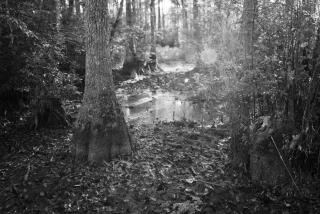Go West, Young Man
- Share via
Despite a contemporary fad for retelling stories of the Bible evident in such books as Anita Diamant’s “The Red Tent” and Jenny Diski’s “Only Human,” few writers are able to approach this material with anything like the purity and passion of the original. One such writer is Michel Tournier.
Renowned in France, Tournier has most frequently found literary inspiration in earlier works and eras. He replayed the tale of Robinson Crusoe in “Friday,” examined the life of the Magi in “The Four Wise Men”--yes, four--and gave his protagonist a job on the hunting preserve of German Reichs- marschall Hermann Goring in his most sinisterly accomplished book, “The Ogre.”
All of these novels look at what most would consider their central stories--Crusoe, Jesus, the Holocaust--from the point of view of a character to the side of the action. In his latest book, “Eleazar, Exodus to the West,” Tournier works by analogy rather than by indirection, as he sets the story of Moses first in pre-potato-famine Ireland and then in mid-19th century America. Shepherd-turned-minister-turned Wild West pioneer, Eleazar O’Braid is an echo of Moses.
Events in O’Braid’s life uncannily reiterate the story of Exodus. For example, when O’Braid sees a young boy mistreated by a landlord’s steward, he lifts his snake-headed walking stick and strikes the man dead as Moses slew an Egyptian slave master whom he caught abusing a worker.
Fearing capture for this crime, O’Braid leads his family into exile. After a brutal sea voyage comparable to the Jews’ journey through Sinai, he aims for California, the name of which echoes--O’Braid is quite conscious of this--Canaan.
If all that “Eleazar, Exodus to the West” did was to formulaically repeat the Bible, we might as well turn to the original, but Tournier is at ease with odd, syncretic discrepancy. The boat’s passage takes 40 days and 40 nights, harking back to the Noah story more than 40 years in the wilderness.
Indeed, the wilderness portion of O’Braid’s journey through the West has yet to begin, and Tournier’s sympathy wavers between figures of the Old and New Testament. While Tournier tells O’Braid’s story fully of Mosaic episodes, he does so from the Gospel’s perspective.
Throughout, Tournier is careful to avoid too absolute an identification between O’Braid and Moses. The former, after all, is “not a madman who thought he was Moses ... he felt his own story to be powerfully attracted to, modeled on, and lent significance by the radiance of the Prophet’s destiny.” Even when the coincidences mount, the author simply speculates, “[C]ould not Eleazar thus believe himself placed under [Moses’] spiritual guidance?” Note that he asks a question rather than making a statement.
Furthermore, Tournier portrays O’Braid, his lame harp-playing wife Esther and their two children, Benjamin and Coralie, as vivid and unique individuals. Benjamin is a lively, curious boy who is bitten by a rattlesnake that he pokes with a stick, though to symbol-seeking Eleazar it seems as if the “aggression by the desert against his son had an initiatory significance.”
Coralie is a natural skeptic who slyly comments in catechism class, “The disciples drank the blood ... but did Jesus himself drink his own blood?” Yet she also has a mystical streak. When the family discovers an arrow in the side of its wagon one morning, she stops Eleazar from removing it. Later, it turns out that the arrow was fired at the moon by a native hunter. The Indians who subsequently threaten the O’Braids see the arrow and, believing that it was sent back from the heavens, grant the family safe passage.
Even the Indians are portrayed with fully human idiosyncrasy when the chief, who helps to heal Benjamin, explicates on the nature of the snake, “Malignant inversion is his vocation.”
Most extraordinary about Tournier’s metaphysical western is the language that he and his characters speak. It’s unafraid of authority and grandeur whether it’s describing a Cincinnati slaughterhouse or a moment of bucolic rapture. Here is one example: “Green Ireland had come between [Eleazar] and the Scriptures. Only the perfectly dry and transparent desert air respected the brutal facts of biblical law.”
“Eleazar, Exodus to the West” is filled with similar images that reflect dual aspects of nature and theology in a manner both resolutely clear and mysteriously evocative. Water and fire serve as elementally alternative modes of existence when Tournier compares the “parched barrenness” of the New World to “the soft, wet soul of Ireland.” Indeed, he recognizes “a fundamental choice between the Spring and the Bush” though he is far too cagey to affirm one Testament over the other. Instead, he lets the symbols clash as they may among the fields of different Lords.
Often accused of perversity, Tournier has made mystical compulsion nearly cauterizing as he simultaneously tells the ancient story of Moses and the 19th century tale of O’Braid. In the meantime, the overlap creates some of the suspense: Because Moses dies in Sinai before he can enter the Promised Land, a reader is prepared for Eleazar’s death yet not certain it will occur.
Nonetheless, the book continues to honor the desperate physical privation of O’Braid’s pilgrimage, as well as to respect the intuition of something beyond. Call it spiritual if you dare. An ocean and a continent are merely the geographical entities crossed in “Eleazar, Exodus to the West.” What’s really crossed here is the boundary between quotidian experience and genuine insight.
More to Read
Sign up for our Book Club newsletter
Get the latest news, events and more from the Los Angeles Times Book Club, and help us get L.A. reading and talking.
You may occasionally receive promotional content from the Los Angeles Times.






